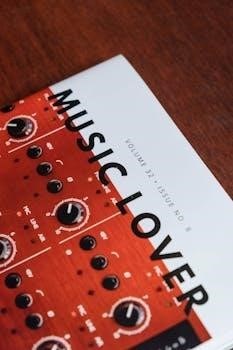Rudolph the Red-Nosed Reindeer Sheet Music PDF⁚ An Overview
This section explores the world of Rudolph the Red-Nosed Reindeer sheet music, a popular choice for musicians of all levels. Discover the different formats and arrangements available, including easy piano versions and options for various instruments. We will delve into resources for free sheet music and explore the features that make this festive tune accessible and enjoyable to play.
The Origins of Rudolph
The story of Rudolph, the red-nosed reindeer, began not as a song but as a booklet created by Robert L. May for the Montgomery Ward department store in 1939. This initially was a marketing tool. May’s creation, intended to be a giveaway, introduced the character of Rudolph, the underdog reindeer with a unique glowing nose. This narrative resonated with audiences and became very popular. The story was then turned into a song, which is why we have sheet music today. The story itself quickly took on a life of its own, paving the way for the iconic Christmas song. This humble beginning laid the foundation for the widespread musical adaptations we enjoy today. The story’s simple yet powerful message of acceptance and celebrating differences is a key element for the sheet music’s popularity.
Robert L. May’s Story
Robert L. May, working for Montgomery Ward, crafted the tale of Rudolph in 1939 as a promotional giveaway. This was a creative solution to a marketing need, and it unexpectedly became a beloved Christmas story. The tale of Rudolph, originally an underdog, was a powerful message for readers. May’s narrative introduced a reindeer who was different, and this difference became his strength. The story’s themes of acceptance and celebrating individuality resonated deeply with audiences. This is why Rudolph was so popular from the start. The success of the booklet led to further adaptations, including the now famous song. The creation of sheet music is, in part, due to the popularity of May’s original story. His creation continues to bring holiday joy.
Johnny Marks’ Song
Johnny Marks, inspired by Robert L. May’s story, composed the iconic “Rudolph the Red-Nosed Reindeer” song in 1949; This song quickly became a Christmas staple, further popularizing the character of Rudolph. The melody is simple yet catchy, contributing to its widespread appeal. Marks’ musical interpretation of May’s story brought Rudolph to a new audience. The song’s success has made it a holiday must-have, and it is now the second best-selling Christmas song of all time. The song’s impact is undeniable, and generations have grown up singing its familiar tune. The availability of sheet music for Marks’ song has made it accessible for musicians to perform, keeping the tune alive each Christmas. His contribution is a significant part of Rudolph’s legacy.

Sheet Music Availability
Finding sheet music for “Rudolph the Red-Nosed Reindeer” is easy with many options available. Resources range from free downloads to paid arrangements, catering to various needs and skill levels.
Free Sheet Music Resources
Numerous websites offer free sheet music for “Rudolph the Red-Nosed Reindeer,” making it accessible to everyone. These resources often include arrangements for various instruments, like piano, guitar, flute, and more. You can find simplified versions for beginners and more complex arrangements for advanced players. Many sites provide downloadable PDFs, allowing you to easily print the music at home. These free options are a great way to learn and enjoy this classic Christmas song without any cost. Some platforms even offer MIDI files, which can be helpful for learning and practicing. Be sure to explore different sites to discover the perfect arrangement for your needs and skill level. Remember to always check the source for copyright information, even with free resources, to ensure you’re using the music responsibly. These free options provide ample opportunity to experience the joy of playing “Rudolph the Red-Nosed Reindeer” during the holiday season.
Piano Sheet Music Options
Piano sheet music for “Rudolph the Red-Nosed Reindeer” is widely available, catering to different skill levels. You can find simple arrangements for beginners, often focusing on single-note melodies with basic chords. These versions are perfect for young learners or those new to the piano. More advanced arrangements include richer harmonies, more complex rhythms, and challenging fingerings for experienced players. Many websites offer free PDF downloads of piano sheet music for this song. These options allow pianists to enjoy playing this beloved Christmas tune. Some arrangements even include the lyrics, making it easier to sing along while playing. Whether you prefer a simple or challenging arrangement, there is a sheet music option to fit your preferences. The availability of varied arrangements ensures that everyone can enjoy playing “Rudolph” on the piano. Explore different versions to find one that suits your musical abilities.
Easy Piano Arrangements
Easy piano arrangements of “Rudolph the Red-Nosed Reindeer” are particularly popular, especially during the Christmas season. These versions are designed for beginners and young students who are just starting to learn the piano. Often, they feature simplified melodies, basic chord progressions, and larger note sizes to aid in reading. Many online resources offer free, printable PDFs of these easy piano arrangements. These beginner-friendly versions often use single notes in the right hand, accompanied by simple chords in the left. This simplified approach allows beginners to play and enjoy the song without feeling overwhelmed. Some easy arrangements include finger numbers to guide beginners. The accessibility of these versions makes it a great choice for learning. It allows even young children to participate in playing Christmas music. These simplified versions of this classic tune make it perfect for family gatherings or school performances.

Sheet Music Details and Features
This section will explore the specific details of “Rudolph the Red-Nosed Reindeer” sheet music, including the key of D arrangements, available instrumental parts and the charm of vintage sheet music options.
Key of D Arrangements
The key of D is a popular choice for “Rudolph the Red-Nosed Reindeer” sheet music, offering a bright and accessible tonality for various instruments. Many arrangements are specifically crafted in this key, making it easier for musicians to play along with recordings or perform in group settings. The D major scale is well-suited for the melody, allowing for smooth transitions and comfortable fingerings on instruments like the piano, violin, and flute. This key often lends itself to cheerful and festive performances, capturing the lighthearted spirit of the song. Having sheet music in the key of D makes the piece more approachable for beginner and intermediate players, allowing them to focus on mastering the rhythm and melody. The key of D provides a good balance between comfortable range and a lively sound, making it a common and practical choice for many sheet music versions.
Instrumental Parts
Sheet music for “Rudolph the Red-Nosed Reindeer” often includes instrumental parts, catering to a variety of musicians beyond just piano players. These parts can be found for instruments such as the violin, viola, cello, and flute, allowing for ensemble performances and diverse musical interpretations. The arrangements might feature solo parts, allowing individual instrumentalists to shine, or provide harmonized lines for a fuller sound. Additionally, some sheet music packages include a full score with all instrumental parts, enabling conductors to lead a group performance effectively. The availability of these parts makes the song accessible to a wider range of musicians, promoting collaborative music-making during the holiday season. Instrumental parts are often clearly marked and formatted to aid in ease of reading and playing. This variety of instrumental options makes the song flexible and enjoyable for musicians of different backgrounds and preferences.

Vintage Sheet Music
Vintage sheet music for “Rudolph the Red-Nosed Reindeer” offers a glimpse into the song’s historical origins and early popularity. These older editions often feature unique cover art, typography, and layouts that reflect the design aesthetics of their time. These vintage copies often hold a nostalgic charm, appealing to collectors and those who appreciate the history of the song. The arrangements in vintage editions might differ slightly from modern versions, providing a fascinating insight into how the song has evolved over time. These sheets can sometimes be found in antique stores, online marketplaces, or through specialized music archives. The aged paper, the slightly faded ink, and the unique fonts all contribute to a sense of history, making it a cherished item for many. The vintage sheet music not only provides a musical score, but also a piece of cultural heritage.

Learning and Playing
This section offers guidance for learning and playing “Rudolph the Red-Nosed Reindeer”. We will explore tips for beginners, discuss group performance options, and touch on copyright and historical context.
Tips for Beginners
For those new to playing “Rudolph the Red-Nosed Reindeer,” starting with easy piano arrangements is highly recommended. These versions simplify the melody and chords, making it less daunting for beginners. Pay close attention to the rhythm and note values, and practice slowly at first to master the tune. Utilize resources like finger-number sheets to aid with hand placement, particularly for non-readers. Consider using color-coded guides, which can help beginners identify notes on the stave more easily. If using the treble clef, you can play the melody on instruments like the flute, violin, or any other melodic non-transposing treble instrument. Remember that consistent practice is key to improving your skills. Take advantage of online resources that offer step-by-step lessons or tutorials. Don’t be afraid to experiment with different tempos to see what feels most comfortable and enjoyable. Finally, be patient with yourself, and have fun learning this classic Christmas song.
Group Performance Options
“Rudolph the Red-Nosed Reindeer” is a fantastic choice for group performances, offering various instrumental combinations. The availability of solo parts for violin, viola, and cello makes it easy to create string ensembles. Consider combining these with a piano accompaniment for a richer sound. Full scores that include violin, viola, cello, and piano parts are available, allowing for a more orchestrated approach. These arrangements facilitate diverse instrument groups working together cohesively. For larger ensembles, adding a choral arrangement can enhance the overall performance. Exploring different instrumental arrangements provides various levels of difficulty, ensuring that all musicians can participate. It’s fun to introduce multiple skill levels within your group. For younger groups, easy piano arrangements or simplified instrumental parts are a great starting point. These kinds of group performance options make “Rudolph” a versatile and enjoyable piece for any ensemble, ensuring a merry and memorable performance.
Copyright and History
“Rudolph the Red-Nosed Reindeer” has a rich history rooted in a 1939 story created by Robert L. May for Montgomery Ward. This story was initially distributed as a giveaway booklet to customers. In 1947, Johnny Marks adapted this story into a song, which quickly became a holiday classic. This song holds the distinction of being the second best-selling Christmas song of all time, demonstrating its lasting impact on popular culture. The copyright for the song and story is crucial, allowing for the creation of various products; May, after acquiring the copyright, was able to produce many items with the Rudolph character. Understanding the copyright is essential when using sheet music, as it protects the intellectual property of the creators. The song’s history and its connection to the original story adds depth to its significance.